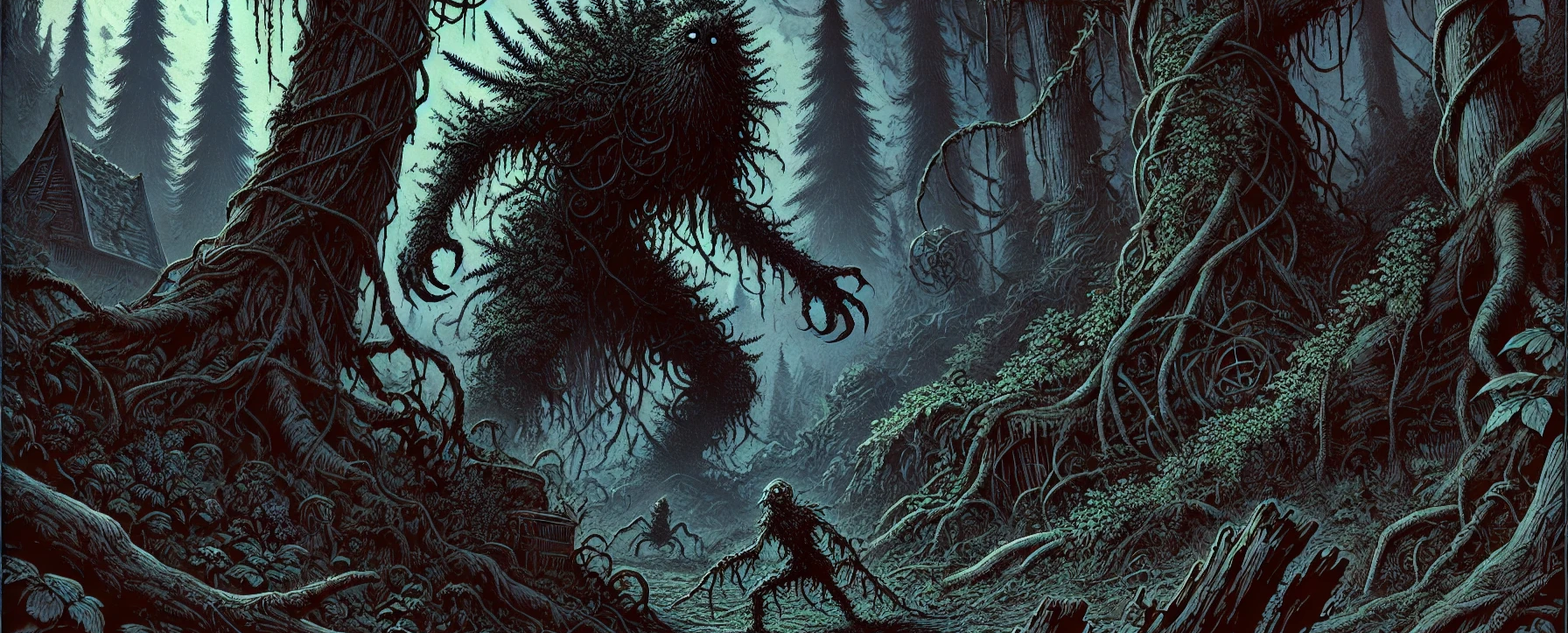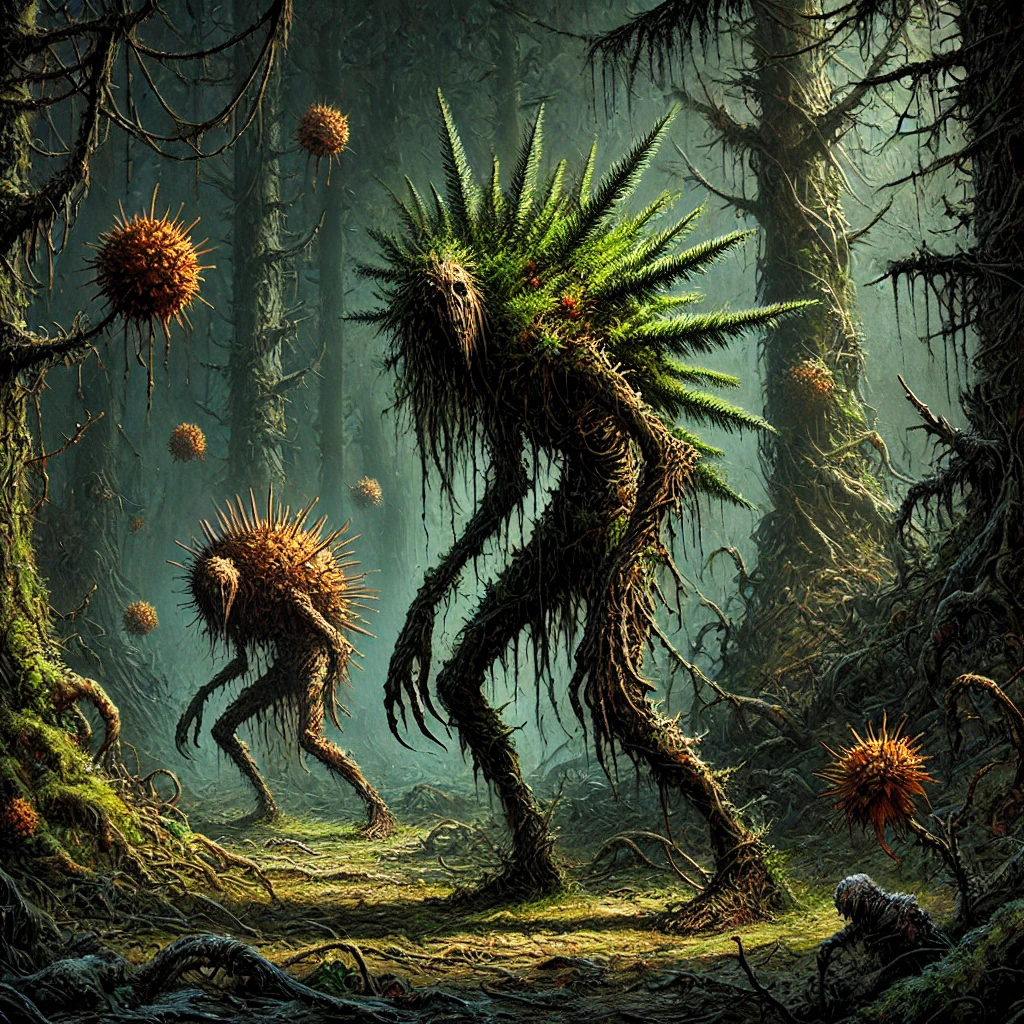Blight (blīt)
Blights are awakened plants imbued with intelligence and mobility, plaguing lands tainted by darkness. These malevolent entities draw their power from the soil contaminated by ancient evil and seek to spread this corruption wherever they go. Resembling twisted versions of their original forms, blights carry out the will of long-lost evil, often continuing the legacy of the dark forces that created them.
Basic Information
Anatomy
Blights appear as twisted, corrupted versions of their original plant forms. They display physical traits that reflect their new, malevolent nature:
- Needle Blights: Resemble conifer-like plants with needles growing in dense clusters across their bodies. From a distance, they might be mistaken for hunched humanoids.
- Twig Blights: When rooted, they look like ordinary woody shrubs. Upon moving, their branches intertwine to form a humanoid shape with defined limbs and a head.
- Vine Blights: Consist of slithering creepers and vines. They often hide in undergrowth, waiting to ensnare their prey.
Genetics and Reproduction
Blights reproduce through a combination of spreading their corruptive influence and infesting healthy plants. This infestation can lead to the rapid creation of new blights, transforming entire ecosystems into hubs of malevolence.
Growth Rate & Stages
Blights grow at an accelerated rate compared to ordinary plants. They progress through stages of development, starting from corrupted seedlings to fully formed blights. Their growth is fueled by the darkness they absorb from the soil and surrounding environment.
Ecology and Habitats
Blights thrive in dark, corrupted environments, often taking root in forests that have been tainted by ancient evil. They can also infest abandoned villages, ruins, and other neglected areas, quickly overtaking the local flora and transforming it into a twisted reflection of its former self.
Dietary Needs and Habits
Blights sustain themselves by absorbing dark energy from the soil and surrounding environment. They can also derive sustenance from the life force of living beings they ensnare and kill. Their presence poisons healthy plants, which they replace with toxic weeds and brambles.
Behaviour
Blights are inherently malevolent and driven by a compulsion to spread corruption. They exhibit behaviors that reflect the traits of the dark forces that created them, often targeting the enemies of their progenitors or seeking out objects of power. Vine blights, with their ability to speak, can taunt or negotiate with their victims, adding a layer of psychological warfare to their tactics.
Additional Information
Social Structure
Blights do not have a structured society. Their actions are directed by the will of the ancient evil that created them. Vine blights, with their ability to communicate, often take on leadership roles within infestations, directing other blights in their efforts to spread corruption.
Geographic Origin and Distribution
Blights can be found in any region that has been contaminated by ancient evil. They are most commonly encountered in dark forests, abandoned villages, and areas with a history of dark magic.
Average Intelligence
Blights possess a basic level of intelligence, sufficient to carry out the will of the evil forces that created them. Vine blights exhibit higher intelligence due to their ability to communicate and strategize.
Perception and Sensory Capabilities
Blights have heightened senses adapted to their environment, allowing them to detect and react to the presence of living beings. Vine blights, in particular, can communicate through a corrupted form of speech, using the voice of the evil spirit that created them.
Symbiotic and Parasitic organisms
Blights have a parasitic relationship with healthy plants, infesting and corrupting them to create new blights. They can also coexist with other dark creatures that thrive in corrupted environments.
Scientific Name
Class: Eudicots
Order: Rosales
Family: Blightaceae
Genus: Blightus
Species: Various (e.g., Blightus aciculus, Blightus ramulus, Blightus vinetus)
Order: Rosales
Family: Blightaceae
Genus: Blightus
Species: Various (e.g., Blightus aciculus, Blightus ramulus, Blightus vinetus)
Lifespan
Blights do not have a fixed lifespan. They can persist indefinitely as long as they have access to dark energy and are not destroyed.
Conservation Status
Blights are considered a significant threat to natural ecosystems and are typically targeted for eradication by those aware of their presence. Their ability to spread corruption rapidly makes them dangerous invaders of healthy forests and farmlands.
Average Height
Needle Blights: 4 to 6 feet
Twig Blights: 2 to 4 feet when rooted, 4 to 6 feet when moving
Vine Blights: Variable, depending on the extent of their creepers
Twig Blights: 2 to 4 feet when rooted, 4 to 6 feet when moving
Vine Blights: Variable, depending on the extent of their creepers
Average Weight
Varies significantly depending on the type and extent of the infestation.
Average Physique
Blights are generally slender and twisted in appearance, with features that reflect their corrupted nature. They are resilient to conventional damage but can be destroyed through fire, radiant energy, or other purifying methods. Blights do not have conventional faces but may display features that resemble eyes, mouths, or other sensory organs, depending on their type. Vine blights can mimic the facial expressions of their progenitors.
Body Tint, Colouring and Marking
Blights typically have dark, muted colors, such as deep greens, browns, and blacks. Their bodies may also exhibit signs of rot or decay, with patches of mold or fungus.





Comments